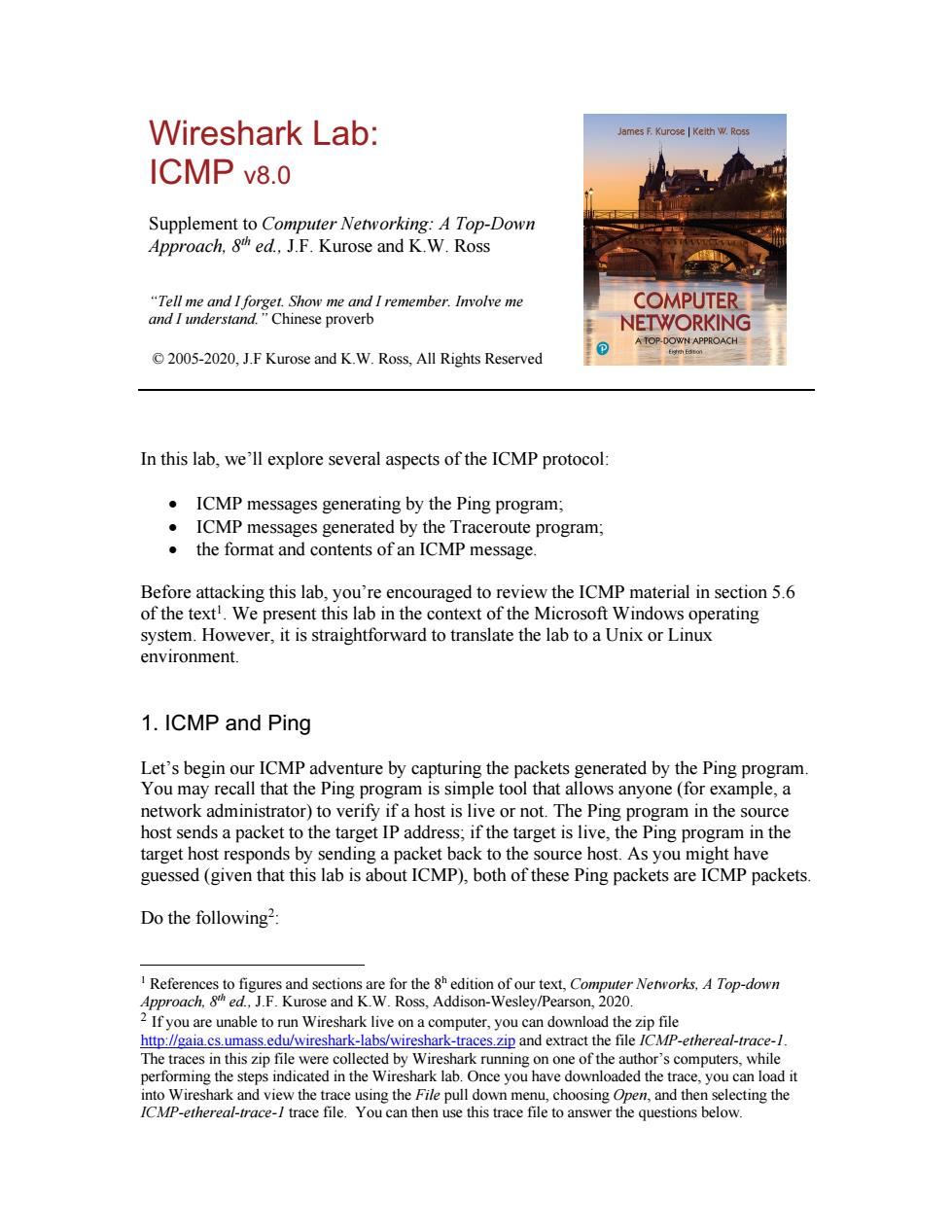正在加载图片...

Wireshark Lab: ICMP v8.0 Supplement to Computer Networking:A Top-Down Approach,8h ed..J.F.Kurose and K.W.Ross COMPUTER NETWORKING 2005-2020.J.F Kurose and K.W.Ross,All Rights Reserved In this lab,we'll explore several aspects of the ICMP protocol: ICMP messages generating by the Ping program; .ICMP messages generated by the Traceroute program the format and contents of an ICMP message ncouraged to re iew the ICMP material in section5.6 of the tex We present this r the ows operating system.However,it is straightforward to translate the lab to a Unix or Linux environment 1.ICMP and Ping ackets You may recall that the Ping progra tworkadmin G. fa ost is live g progra he host sen a pack t to the target IP dd arg ing pros ram in the arget a pa guesed ().both packets are ICMP packets Do the following? nforences to figures and sectionk w Ross.Addison-Wesley/Pearson.2020 op-down ose a ison-Wesley/Pears e把吸 The traces in thiszip file were collected by Wireshark runningon one of the author's computers.while erforming the ste eps indicated in the Wireshark lab.Once you have downloaded the e,you can lo cting the Wireshark Lab: ICMP v8.0 Supplement to Computer Networking: A Top-Down Approach, 8th ed., J.F. Kurose and K.W. Ross “Tell me and I forget. Show me and I remember. Involve me and I understand.” Chinese proverb © 2005-2020, J.F Kurose and K.W. Ross, All Rights Reserved In this lab, we’ll explore several aspects of the ICMP protocol: • ICMP messages generating by the Ping program; • ICMP messages generated by the Traceroute program; • the format and contents of an ICMP message. Before attacking this lab, you’re encouraged to review the ICMP material in section 5.6 of the text1 . We present this lab in the context of the Microsoft Windows operating system. However, it is straightforward to translate the lab to a Unix or Linux environment. 1. ICMP and Ping Let’s begin our ICMP adventure by capturing the packets generated by the Ping program. You may recall that the Ping program is simple tool that allows anyone (for example, a network administrator) to verify if a host is live or not. The Ping program in the source host sends a packet to the target IP address; if the target is live, the Ping program in the target host responds by sending a packet back to the source host. As you might have guessed (given that this lab is about ICMP), both of these Ping packets are ICMP packets. Do the following2 : 1 References to figures and sections are for the 8h edition of our text, Computer Networks, A Top-down Approach, 8th ed., J.F. Kurose and K.W. Ross, Addison-Wesley/Pearson, 2020. 2 If you are unable to run Wireshark live on a computer, you can download the zip file http://gaia.cs.umass.edu/wireshark-labs/wireshark-traces.zip and extract the file ICMP-ethereal-trace-1. The traces in this zip file were collected by Wireshark running on one of the author’s computers, while performing the steps indicated in the Wireshark lab. Once you have downloaded the trace, you can load it into Wireshark and view the trace using the File pull down menu, choosing Open, and then selecting the ICMP-ethereal-trace-1 trace file. You can then use this trace file to answer the questions below